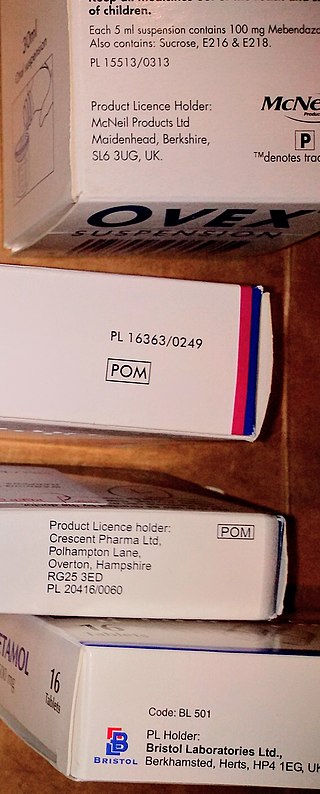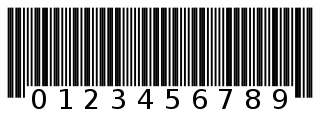
The United States Food and Drug Administration is a federal agency of the Department of Health and Human Services. The FDA is responsible for protecting and promoting public health through the control and supervision of food safety, tobacco products, caffeine products, dietary supplements, prescription and over-the-counter pharmaceutical drugs (medications), vaccines, biopharmaceuticals, blood transfusions, medical devices, electromagnetic radiation emitting devices (ERED), cosmetics, animal foods & feed and veterinary products.

Over-the-counter (OTC) drugs are medicines sold directly to a consumer without a requirement for a prescription from a healthcare professional, as opposed to prescription drugs, which may be supplied only to consumers possessing a valid prescription. In many countries, OTC drugs are selected by a regulatory agency to ensure that they contain ingredients that are safe and effective when used without a physician's care. OTC drugs are usually regulated according to their active pharmaceutical ingredient (API) and strengths of final products.

In the metric system, a microgram or microgramme is a unit of mass equal to one millionth of a gram. The unit symbol is μg according to the International System of Units (SI); the recommended symbol in the United States and United Kingdom when communicating medical information is mcg. In μg, the prefix symbol for micro- is the Greek letter μ (mu).

A prescription drug is a pharmaceutical drug that is permitted to be dispensed only to those with a medical prescription. In contrast, over-the-counter drugs can be obtained without a prescription. The reason for this difference in substance control is the potential scope of misuse, from drug abuse to practicing medicine without a license and without sufficient education. Different jurisdictions have different definitions of what constitutes a prescription drug.

Rosiglitazone is an antidiabetic drug in the thiazolidinedione class. It works as an insulin sensitizer, by binding to the PPAR in fat cells and making the cells more responsive to insulin. It is marketed by the pharmaceutical company GlaxoSmithKline (GSK) as a stand-alone drug or for use in combination with metformin or with glimepiride. First released in 1999, annual sales peaked at approximately $2.5-billion in 2006; however, following a meta-analysis in 2007 that linked the drug's use to an increased risk of heart attack, sales plummeted to just $9.5-million in 2012. The drug's patent expired in 2012.
A medical error is a preventable adverse effect of care ("iatrogenesis"), whether or not it is evident or harmful to the patient. This might include an inaccurate or incomplete diagnosis or treatment of a disease, injury, syndrome, behavior, infection, or other ailments.
Off-label use is the use of pharmaceutical drugs for an unapproved indication or in an unapproved age group, dosage, or route of administration. Both prescription drugs and over-the-counter drugs (OTCs) can be used in off-label ways, although most studies of off-label use focus on prescription drugs.
A patient safety organization (PSO) is a group, institution, or association that improves medical care by reducing medical errors. Common functions of patient safety organizations are data collection, analysis, reporting, education, funding, and advocacy. A PSO differs from a Federally designed Patient Safety Organization (PSO), which provides health care providers in the U.S. privilege and confidentiality protections for efforts to improve patient safety and the quality of patient care delivery

In the field of pharmacy, compounding is preparation of custom medications to fit unique needs of patients that cannot be met with mass-produced products. This may be done, for example, to provide medication in a form easier for a given patient to ingest, or to avoid a non-active ingredient a patient is allergic to, or to provide an exact dose that isn't otherwise available. This kind of patient-specific compounding, according to a prescriber's specifications, is referred to as "traditional" compounding. The nature of patient need for such customization can range from absolute necessity to individual optimality to even preference.
In medicine, an indication is a valid reason to use a certain test, medication, procedure, or surgery. There can be multiple indications to use a procedure or medication. An indication can commonly be confused with the term diagnosis. A diagnosis is the assessment that a particular medical condition is present while an indication is a reason for use. The opposite of an indication is a contraindication, a reason to withhold a certain medical treatment because the risks of treatment clearly outweigh the benefits.
Health information technology (HIT) is health technology, particularly information technology, applied to health and health care. It supports health information management across computerized systems and the secure exchange of health information between consumers, providers, payers, and quality monitors. Based on a 2008 report on a small series of studies conducted at four sites that provide ambulatory care – three U.S. medical centers and one in the Netherlands, the use of electronic health records (EHRs) was viewed as the most promising tool for improving the overall quality, safety and efficiency of the health delivery system.
Procaine benzylpenicillin also known as penicillin G procaine, is an antibiotic useful for the treatment of a number of bacterial infections. Specifically it is used for syphilis, anthrax, mouth infections, pneumonia, diphtheria, cellulitis, and animal bites. It is given by injection into a muscle.

Bar code medication administration (BCMA) is a barcode system designed by Glenna Sue Kinnick to prevent medication errors in healthcare settings and to improve the quality and safety of medication administration. The overall goals of BCMA are to improve accuracy, prevent errors, and generate online records of medication administration.
Michael Cohen is an American pharmacist, and president of the Institute for Safe Medication Practices (ISMP). He was a 2005 MacArthur Fellow.
Barcode technology in healthcare is the use of optical machine-readable representation of data in a hospital or healthcare setting.

Drug labelling is also referred to as prescription labelling, is a written, printed or graphic matter upon any drugs or any of its container, or accompanying such a drug. Drug labels seek to identify drug contents and to state specific instructions or warnings for administration, storage and disposal. Since 1800s, legislation has been advocated to stipulate the formats of drug labelling due to the demand for an equitable trading platform, the need of identification of toxins and the awareness of public health. Variations in healthcare system, drug incidents and commercial utilization may attribute to different regional or national drug label requirements. Despite the advancement in drug labelling, medication errors are partly associated with undesirable drug label formatting.
The Institute for Safe Medication Practices (ISMP) is an American 501(c)(3) organization focusing on the prevention of medication errors and promoting safe medication practices. It is affiliated with ECRI.

Tapinarof, also known as benvitimod and sold under the brand name Vtama, is a medication used for the treatment of plaque psoriasis. The medication is applied to the skin. Besides its use in medicine, tapinarof is a naturally occurring compound found in bacterial symbionts of nematodes which has antibiotic properties.








